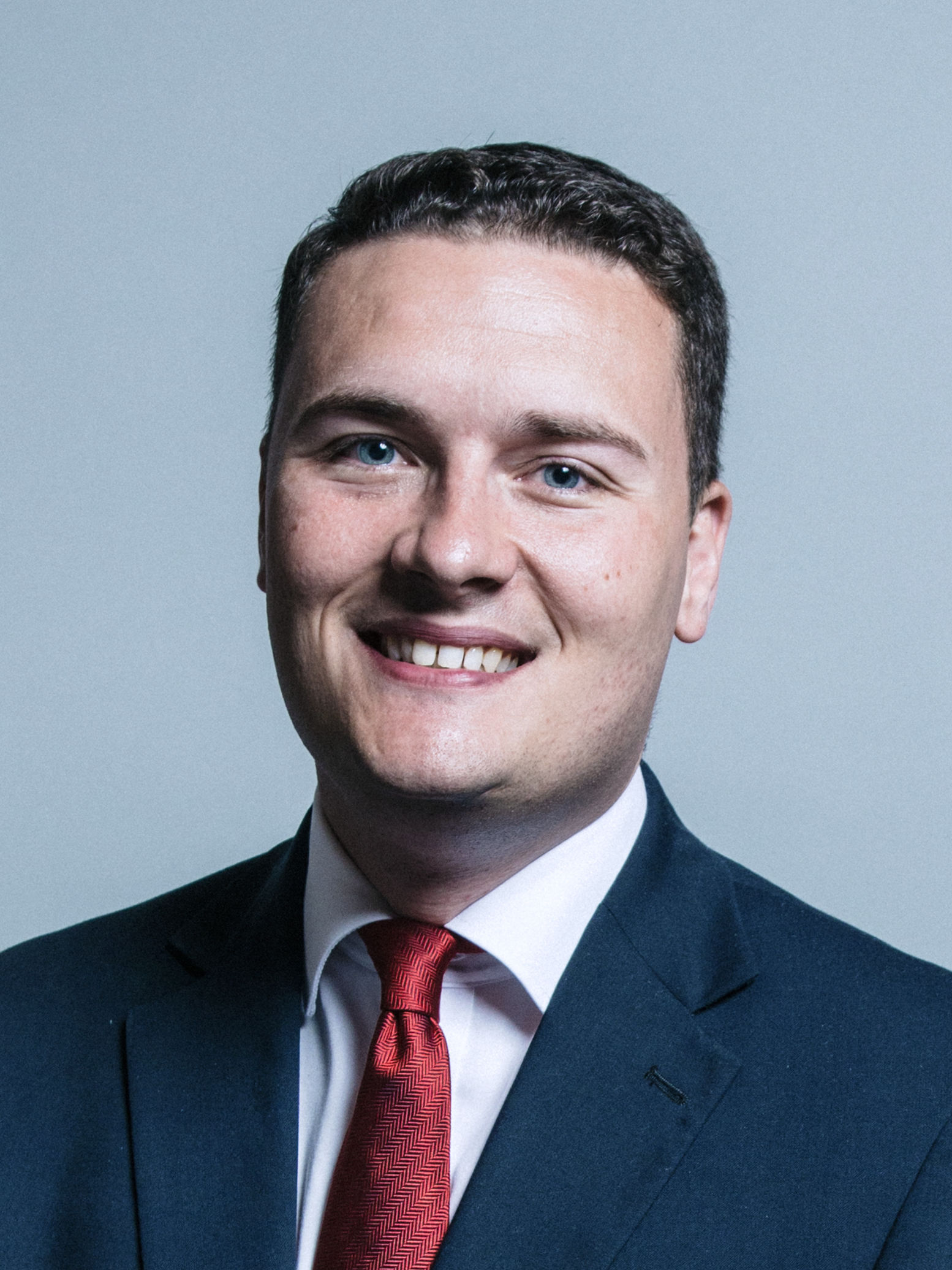Department of Health and Social Care
We support ministers in leading the nation’s health and social care to help people live more independent, healthier lives for longer.
Shadow Ministers / Spokeperson
Liberal Democrat
Helen Morgan (LD - North Shropshire)Liberal Democrat Spokesperson (Health and Social Care)
Danny Chambers (LD - Winchester)
Liberal Democrat Spokesperson (Mental Health)
Lord Scriven (LD - Life peer)
Liberal Democrat Lords Spokesperson (Health)
Scottish National Party
Seamus Logan (SNP - Aberdeenshire North and Moray East)Shadow SNP Spokesperson (Health and Social Care)
Green Party
Adrian Ramsay (Green - Waveney Valley)Green Spokesperson (Health)
Conservative
Stuart Andrew (Con - Daventry)Shadow Secretary of State for Health and Social Care
Junior Shadow Ministers / Deputy Spokesperson
Conservative
Lord Kamall (Con - Life peer)Shadow Minister (Health and Social Care)
Caroline Johnson (Con - Sleaford and North Hykeham)
Shadow Minister (Health and Social Care)
Junior Shadow Ministers / Deputy Spokesperson
Conservative
Luke Evans (Con - Hinckley and Bosworth)Shadow Parliamentary Under Secretary (Health and Social Care)
Ministers of State
Stephen Kinnock (Lab - Aberafan Maesteg)Minister of State (Department of Health and Social Care)
Karin Smyth (Lab - Bristol South)
Minister of State (Department of Health and Social Care)
Parliamentary Under-Secretaries of State
Baroness Merron (Lab - Life peer)Parliamentary Under-Secretary (Department of Health and Social Care)
Ashley Dalton (Lab - West Lancashire)
Parliamentary Under-Secretary (Department of Health and Social Care)
Zubir Ahmed (Lab - Glasgow South West)
Parliamentary Under-Secretary (Department of Health and Social Care)
11:58
Written Evidence
The Committee is holding an inquiry into what is needed from the NHS estate to deliver the Government’s vision of …
To ask the Secretary of State for Health and Social Care, what steps he is taking to improve the (a) …
These Regulations make amendments to the Medical Devices Regulations 2002 (“the 2002 Regulations”) and the Medical Devices (Northern Ireland Protocol) …
A Bill to make provision to amend the Mental Health Act 1983 in relation to mentally disordered persons; and for …
Department of Health and Social Care Commons Appearances
Oral Answers to Questions is a regularly scheduled appearance where the Secretary of State and junior minister will answer at the Dispatch Box questions from backbench MPs
Other Commons Chamber appearances can be:- Urgent Questions where the Speaker has selected a question to which a Minister must reply that day
- Adjornment Debates a 30 minute debate attended by a Minister that concludes the day in Parliament.
- Oral Statements informing the Commons of a significant development, where backbench MP's can then question the Minister making the statement.
Westminster Hall debates are performed in response to backbench MPs or e-petitions asking for a Minister to address a detailed issue
Written Statements are made when a current event is not sufficiently significant to require an Oral Statement, but the House is required to be informed.
Most Recent Commons Appearances by Category
Bills currently before Parliament
Department of Health and Social Care does not have Bills currently before Parliament
Acts of Parliament created in the 2024 Parliament
A Bill to make provision to amend the Mental Health Act 1983 in relation to mentally disordered persons; and for connected purposes.
This Bill received Royal Assent on 18th December 2025 and was enacted into law.
Department of Health and Social Care - Secondary Legislation
Petitions
e-Petitions are administered by Parliament and allow members of the public to express support for a particular issue.
If an e-petition reaches 10,000 signatures the Government will issue a written response.
If an e-petition reaches 100,000 signatures the petition becomes eligible for a Parliamentary debate (usually Monday 4.30pm in Westminster Hall).
(1,399 in the last 7 days)
(1,199 in the last 7 days)
(1,096 in the last 7 days)
(1,020 in the last 7 days)
(924 in the last 7 days)
(1,399 in the last 7 days)
(172 in the last 7 days)
(17 in the last 7 days)
(507 in the last 7 days)
(15 in the last 7 days)
Petition Closed
Increase funding for people with Parkinson’s and implement the "Parky Charter"
Gov Responded - 29 Apr 2025closed 3 months, 2 weeks ago
We want the government to take the decisive five steps set out in the Movers and Shakers' "Parky Charter" and to fulfil the Health Secretary’s promises.
Departmental Select Committee
Health and Social Care Committee
Commons Select Committees are a formally established cross-party group of backbench MPs tasked with holding a Government department to account.
At any time there will be number of ongoing investigations into the work of the Department, or issues which fall within the oversight of the Department. Witnesses can be summoned from within the Government and outside to assist in these inquiries.
Select Committee findings are reported to the Commons, printed, and published on the Parliament website. The government then usually has 60 days to reply to the committee's recommendations.
11 Members of the Health and Social Care Committee

Health and Social Care Committee Member since 9th September 2024

Health and Social Care Committee Member since 21st October 2024

Health and Social Care Committee Member since 21st October 2024

Health and Social Care Committee Member since 21st October 2024

Health and Social Care Committee Member since 21st October 2024

Health and Social Care Committee Member since 21st October 2024

Health and Social Care Committee Member since 21st October 2024

Health and Social Care Committee Member since 21st October 2024

Health and Social Care Committee Member since 21st October 2024

Health and Social Care Committee Member since 28th October 2024

Health and Social Care Committee Member since 17th March 2025
Health and Social Care Committee: 9 Current Inquiries
Health and Social Care Committee: Previous Inquiries
50 most recent Written Questions
(View all written questions)We’re improving referral processing by introducing a Single Point of Access model, which will provide consistent clinical triage and use digital solutions to streamline processes and reduce duplication. This will ensure patients are directed to the right care quickly.
To support general practitioners and avoid delays, we’re introducing national standards for response times and guidance to underpin clinical triage and advice quality. These will be monitored locally by integrated care boards and reviewed regularly.
The NHS App also already allows people to book and manage their secondary care referrals in 100% of acute trusts, with 89% allowing patients to manage follow up appointments too, with 100% expected in 2026.
Parliamentary Under-Secretary (Department of Health and Social Care)
No such assessment has been made. We recognise that people are facing unacceptably long waiting times to access mental health support. This is why we are transforming the current mental health system so people can access the right support, at the right time, in the right place.
Building on the 10-Year Health Plan, the NHS Medium Term Planning Framework, published on 24 October 2025, sets targets for integrated care boards in 2026/27 to improve quality and access to mental health services. This includes expanding NHS Talking Therapies and expanding coverage of mental health support teams in schools and colleges.
This builds on the significant progress we’ve made since July 2024 to hire almost 7,000 extra mental health workers. And by spring next year, over 900,000 children and young people will have access to a Mental Health Support team in schools and colleagues.
Parliamentary Under-Secretary (Department of Health and Social Care)
The General Medical Council (GMC) is the regulator of all medical doctors, physician assistants and physician assistants in anaesthesia, still legally known as anaesthesia associates and physician associates, practising in the United Kingdom. The GMC is independent of Government, directly accountable to Parliament and is responsible for operational matters concerning the discharge of its statutory duties.
The Government has had discussions with the GMC on this issue. The GMC’s Good Medical Practice states that professionals must act with honesty and integrity and ensure their conduct justifies patient’s trust in them and the public’s trust in the profession. They must also recognise a patient’s right to choose whether to accept their advice. It is up to individual healthcare providers, rather than the GMC, to consider patient requests for care based on sex.
Parliamentary Under-Secretary (Department of Health and Social Care)
The General Medical Council (GMC) is the regulator of all medical doctors, physician assistants and physician assistants in anaesthesia, still legally known as anaesthesia associates and physician associates, practising in the United Kingdom. The GMC is independent of Government, directly accountable to Parliament and is responsible for operational matters concerning the discharge of its statutory duties.
The GMC maintains the official register of registered medical practitioners. Under the Form and Content of the Register Regulations, the GMC records a doctor's gender rather than sex.
The Government has had some discussions with the GMC about this topic. In light of the Supreme Court ruling in the case of For Women Scotland v. The Scottish Ministers regarding the meaning of “sex” in the Equality Act 2010, the GMC is in the process of reviewing its policy position regarding the recording of a doctor’s gender or biological sex on its registers.
Parliamentary Under-Secretary (Department of Health and Social Care)
Five executive senior managers at NHS England have left since 1 March 2025 and received a payment in lieu of notice. These payments total £553,252.15. 12 executive senior managers at NHS England have left since 1 March 2025 and received a payment in lieu of annual leave. These payments total £124,015.62.
Parliamentary Under-Secretary (Department of Health and Social Care)
This information is not held centrally as NHS England do not collect supplier payment information on behalf of National Health Service trusts.
Parliamentary Under-Secretary (Department of Health and Social Care)
The Government is clear that patients should expect and receive the highest standard of care throughout the year, including during the busy winter period.
We started earlier and have done more than ever to prepare for winter this year. We continue to monitor the impact of winter pressures on the National Health Service over the winter months, providing additional support to services across the country as needed.
Flu is a recurring pressure that the NHS faces every winter. There is particular risk of severe illness for older people, the very young, pregnant people, and those with certain underlying health conditions. The flu vaccine remains the best form of defense against influenza, particularly for the most vulnerable, and continues to be highly effective at preventing severe disease and hospitalisation.
Decisions about recruitment and resourcing are a matter for individual NHS employers, who manage this at a local level to ensure they have the staff they need to deliver safe and effective care.
Parliamentary Under-Secretary (Department of Health and Social Care)
Steve Witherden
(Labour - Montgomeryshire and Glyndwr)
The Department and the National Infrastructure and Service Transformation Authority (NISTA) will continue to work with the market to further develop the new Public Private Partnership (PPP) model for neighbourhood health centres (NHCs) with further engagement next year. The final design and development of this new PPP model for NHCs will be led by NISTA and co-designed by the Department.
The Department has no plans to publish the NHC PPP Feasibility Programme Business Case. Publication is not standard practice for business cases outside of the Government Major Projects Portfolio.
Minister of State (Department of Health and Social Care)
The Department has no plans to publish the Neighbourhood Health Centre (NHC) Public Private Partnership (PPP) Feasibility Programme Business Case. Publication is not standard practice for business cases outside of the Government’s Major Projects Portfolio. This was a strategic outline business case, the purpose of which was to scope and identify the preferred way forward for a new potential PPP model in line with the HM Treasury five case model.
The Department and the National Infrastructure and Service Transformation Authority (NISTA) will continue to work with the market to further develop the new PPP model for NHCs, with further engagement next year. The final design and development of this new PPP model for NHCs will be led by NISTA and will be co-designed by the Department.
Minister of State (Department of Health and Social Care)
At the Autumn Budget, we announced our commitment to deliver 250 Neighbourhood Health Centres (NHCs) through the NHS Neighbourhood Rebuild Programme. This will deliver NHCs through a mixture of refurbishments, to expand and improve sites over the next three years, and new-build sites opening in the medium term.
The first 120 NHCs are due to be operational by 2030, delivered through public private partnerships (PPPs) and public capital. 50 NHCs will be completed through the repurposing of the existing estate with public sector funding, and 70 through new builds by 2030. 80% of the new builds will be PPPs, with a further 20% coming from public sector investment.
The Spending Review has seen the Government provide £426 million over four years through the Utilisation and Modernisation Fund, upgrading general practice estates and supporting delivery of 40 to 50 neighbourhood health centres this Parliament through the refurbishment of existing buildings.
Minister of State (Department of Health and Social Care)
As set out in the 10 Year Infrastructure Strategy (the Strategy) and the 10-Year Health Plan, in addition to significant capital investment, the Government would explore the feasibility of using new Public Private Partnership (PPP) models for taxpayer-funded projects in very limited circumstances, where they could represent value for money. This included the potential use of PPPs to deliver Neighbourhood Health Centres (NHCs).
A business case was developed by the Department and supported by National Infrastructure and Service Transformation Authority (NISTA). The business case was considered by ministers and has resulted in the announcement in the Budget published on 26 November 2025.
The Budget builds on the Strategy and the 10-Year Health Plan by confirming that the NHS Neighbourhood Rebuild Programme will deliver new NHCs through upgrading and repurposing existing buildings and building new facilities through a combination of public sector investment and a new model of PPPs.
This new PPP model is being developed by NISTA, and is supported by the Department, and will ensure private sector expertise is harnessed to deliver these assets on time and on budget.
The new model will build on lessons from the past and other models currently in use, and will draw on lessons learnt, including the National Audit Office’s 2025 report on private finance.
To ensure the NHC PPPs are managed transparently and are fiscally sustainable, these partnerships will be budgeted for as if they are on a balance sheet.
Delivering new NHCs through a combination of public investment and PPPs will also allow, for the first time, for evidence to be built and compared between different delivery models.
Minister of State (Department of Health and Social Care)
Each risk in the National Risk Register has a designated Risk Owner, working within the lead Government department which is responsible for designated risk areas.
The Department’s roles and accountabilities in relation to overall risk, and responsibility for managing emergencies, are outlined on the GOV.UK website, at the following link:
Minister of State (Department of Health and Social Care)
The Department holds data based on the application process for medical specialty training which allows the identification of unique applicants. This data is part of management information systems summarising information supplied in medical specialty training cycles. Applicants may have chosen to only apply to one specialty programme or may have made multiple applications within the year.
The following table shows the number of unique applicants in rounds one and two of medical specialty training for 2025 and the associated training places available across the United Kingdom:
Round one | Round two | |
Unique applicants | 33,870 | 8,481 |
Training posts | 9,479 | 3,354 |
Source: NHS England Medical Specialty Programme Applications Data.
Round one of the medical specialty application process includes applications to first year specialty training and core training programmes, often referred to as ST1 and CT1 respectively, and some ‘higher’ medical specialty training programmes, usually at year three, often referred to as ST3. Round two is for entry to most ‘higher’ medical specialty training programmes, ST3 or ST4. There will be a limited number of doctors who apply in a year to both rounds one and two.
Information on the number of applications and posts available for individual medical specialty training programmes is published annually by NHS England and can be found at the following link:
The 10-Year Health Plan set out that 1,000 more specialty training places would be created over the next three years.
On 8 December, the Government put an offer in writing to the British Medical Association Resident Doctors Committee which would have put in place emergency legislation in the new year which would prioritise United Kingdom and Republic of Ireland medical graduates for foundation training, and prioritise UK and Republic of Ireland medical graduates and doctors who have worked in the National Health Service for a significant period of time for specialty training. This would have applied for current applicants for training posts starting in 2026, and every year after that.
The British Medical Association has rejected the Government's offer and the Government will consider its next steps.
Minister of State (Department of Health and Social Care)
Upon entering the National Health Service after graduation, medical students enter a two-year period of foundation programme placements. The United Kingdom Foundation Programme Office has successfully allocated foundation programme places to all eligible applicants in each of the past three years. These total 10,634 applicants for the 2025 programme, 9,702 for the 2024 programme, and 8,655 in 2023.
Upon successful completion of the foundation programme most doctors choose to apply for speciality training programmes. Competition for speciality training posts has grown in recent years, in part due to the introduction of health and care visas in 2020, as well as the decision to remove the Resident Labour Market Test for doctors in 2020 which has meant that more international medical graduates are applying for speciality training places, increasing the number of candidates for roles.
The table below presents the number of specialist training program applicants and the number of available posts in England by round. The difference between these two numbers is not exactly the number of candidates unable to secure a position as some applicants may not meet the thresholds set for recruitment to specialty training and some may be offered a specialty training post but for a range of reasons do not take up that position.
Round One | Round Two | |||
Entry year | Unique Applicants | Available Posts | Unique Applicants | Available Posts |
2023 | 20,297 | 9,265 | 6,081 | 3,415 |
2024 | 26,203 | 9,331 | 7,179 | 3,412 |
2025 | 33,870 | 9,479 | 8,481 | 3,354 |
Source: NHS England Medical Specialty Programme Applications Data.
Round one of the medical specialty application process includes applications to first year specialty training and core training programmes, often referred to as ST1 and CT1 respectively, and some ‘higher’ medical specialty training programmes, usually at year three, often referred to as ST3. Round two is for entry to most ‘higher’ medical specialty training programmes, ST3 or ST4. There will be a limited number of doctors who apply in a year to both rounds one and two.
The 10-Year Health Plan set out that 1,000 more specialty training places would be created over the next three years.
On 8 December, the Government put an offer in writing to the British Medical Association Resident Doctors Committee which would have put in place emergency legislation in the new year which would prioritise UK and Republic of Ireland medical graduates for foundation training, and prioritise UK and Republic of Ireland medical graduates and doctors who have worked in the NHS for a significant period of time for specialty training. This would have applied for current applicants for training posts starting in 2026, and every year after that.
The British Medical Association has rejected the Government's offer and the Government will consider its next steps.
Minister of State (Department of Health and Social Care)
Neil O'Brien
(Conservative - Harborough, Oadby and Wigston)
The table attached shows the annual budget and the number of full time equivalent (FTE) employees for the UK Health Security Agency, the Food Standards Agency, the Medicines and Healthcare products Regulatory Agency, the Care Quality Commission, and the National Institute for Health and Care Excellence, each year from 2005/06 to 2024/25. The number of people employed by each arm's-length body has been recorded as FTE (payroll). The annual budget comprises both the Resource Departmental Expenditure Limit and the Capital Departmental Expenditure Limit to give the total Departmental Expenditure Limit budget.
Minister of State (Department of Health and Social Care)
Neil O'Brien
(Conservative - Harborough, Oadby and Wigston)
The table attached shows the annual budget and the number of full time equivalent (FTE) employees for the UK Health Security Agency, the Food Standards Agency, the Medicines and Healthcare products Regulatory Agency, the Care Quality Commission, and the National Institute for Health and Care Excellence, each year from 2005/06 to 2024/25. The number of people employed by each arm's-length body has been recorded as FTE (payroll). The annual budget comprises both the Resource Departmental Expenditure Limit and the Capital Departmental Expenditure Limit to give the total Departmental Expenditure Limit budget.
Minister of State (Department of Health and Social Care)
Neil O'Brien
(Conservative - Harborough, Oadby and Wigston)
The table attached shows the annual budget and the number of full time equivalent (FTE) employees for the UK Health Security Agency, the Food Standards Agency, the Medicines and Healthcare products Regulatory Agency, the Care Quality Commission, and the National Institute for Health and Care Excellence, each year from 2005/06 to 2024/25. The number of people employed by each arm's-length body has been recorded as FTE (payroll). The annual budget comprises both the Resource Departmental Expenditure Limit and the Capital Departmental Expenditure Limit to give the total Departmental Expenditure Limit budget.
Minister of State (Department of Health and Social Care)
Neil O'Brien
(Conservative - Harborough, Oadby and Wigston)
The table attached shows the annual budget and the number of full time equivalent (FTE) employees for the UK Health Security Agency, the Food Standards Agency, the Medicines and Healthcare products Regulatory Agency, the Care Quality Commission, and the National Institute for Health and Care Excellence, each year from 2005/06 to 2024/25. The number of people employed by each arm's-length body has been recorded as FTE (payroll). The annual budget comprises both the Resource Departmental Expenditure Limit and the Capital Departmental Expenditure Limit to give the total Departmental Expenditure Limit budget.
Minister of State (Department of Health and Social Care)
Funding decisions for fertility services, including cases where a surrogate may be involved, are made by integrated care boards (ICBs), which are responsible for commissioning services based on the clinical needs of their populations. We expect ICBs to commission fertility services in line with National Institute for Health and Care Excellence (NICE) guidelines to support fair and consistent access across England.
NICE is currently reviewing the fertility guidelines and will consider whether its current recommendations for access to National Health Service funded treatment are still appropriate. A consultation on revised guidelines was published on 10 September and closed on 21 October 2025. The outcome of this review will support ICBs in making commissioning decisions that promote equitable access to fertility services, including for those whose fertility has been affected by medical treatment such as cancer.
Work continues between the Department and NHS England to analyse the current understanding and provision of NHS funded fertility services and address longstanding variation in access.
Minister of State (Department of Health and Social Care)
The Government highly values hardworking National Health Service staff who go above and beyond to provide rapid and critical care. Local NHS trusts have in place their own approaches to recognising and rewarding staff, supported by advice and guidance set out in the Staff Recognition Framework, which is available at the following link:
https://www.england.nhs.uk/long-read/staff-recognition-framework/
Members of Parliament can also acknowledge the work of NHS staff in their constituency through the NHS Parliamentary Awards, with further information available at the following link:
Minister of State (Department of Health and Social Care)
The annual allowance limits the amount that an individual can save in their pension pot before they have to pay tax. It aims to ensure that the incentives for pension saving, which are costly to the taxpayer, are appropriately targeted across society. Tax policy, including the level of the annual allowance, is a matter for my Rt. Hon. Friend, the Chancellor of the Exchequer.
From 6 April 2023, the previous administration introduced reforms to the annual allowance, increasing both the standard and tapered annual allowances, allowing National Health Service staff to save more into their pensions each year before facing a tax charge.
Where NHS staff have pension savings that exceed the annual allowance, for example due to unexpected circumstances such as taking on extra hours or additional responsibilities within the NHS, they can carry forward any unused annual allowance from the previous three tax years. This will increase their current year’s allowance, reducing or potentially avoiding any annual allowance tax charge that is due.
Additionally, the NHS Pension Scheme offers a Scheme Pays facility which allows impacted members to pay charges using the value of their pension. This spreads the cost of paying a tax charge over the lifetime of the pension rather than requiring an immediate outlay. For most members, the growth in their pension benefits at retirement, even net of a charge, would still represent an excellent return on their pension contributions.
Information for trusts is available on NHS Employers website, which is available at the following link:
https://www.nhsemployers.org/publications/annual-allowance.
Information for members is available on the NHS Pensions website, which is available at the following link:
Minister of State (Department of Health and Social Care)
The annual allowance limits the amount that an individual can save in their pension pot before they have to pay tax. It aims to ensure that the incentives for pension saving, which are costly to the taxpayer, are appropriately targeted across society. Tax policy, including the level of the annual allowance, is a matter for my Rt. Hon. Friend, the Chancellor of the Exchequer.
From 6 April 2023, the previous administration introduced reforms to the annual allowance, increasing both the standard and tapered annual allowances, allowing National Health Service staff to save more into their pensions each year before facing a tax charge.
Where NHS staff have pension savings that exceed the annual allowance, for example due to unexpected circumstances such as taking on extra hours or additional responsibilities within the NHS, they can carry forward any unused annual allowance from the previous three tax years. This will increase their current year’s allowance, reducing or potentially avoiding any annual allowance tax charge that is due.
Additionally, the NHS Pension Scheme offers a Scheme Pays facility which allows impacted members to pay charges using the value of their pension. This spreads the cost of paying a tax charge over the lifetime of the pension rather than requiring an immediate outlay. For most members, the growth in their pension benefits at retirement, even net of a charge, would still represent an excellent return on their pension contributions.
Information for trusts is available on NHS Employers website, which is available at the following link:
https://www.nhsemployers.org/publications/annual-allowance.
Information for members is available on the NHS Pensions website, which is available at the following link:
Minister of State (Department of Health and Social Care)
The annual allowance limits the amount that an individual can save in their pension pot before they have to pay tax. It aims to ensure that the incentives for pension saving, which are costly to the taxpayer, are appropriately targeted across society. Tax policy, including the level of the annual allowance, is a matter for my Rt. Hon. Friend, the Chancellor of the Exchequer.
From 6 April 2023, the previous administration introduced reforms to the annual allowance, increasing both the standard and tapered annual allowances, allowing National Health Service staff to save more into their pensions each year before facing a tax charge.
Where NHS staff have pension savings that exceed the annual allowance, for example due to unexpected circumstances such as taking on extra hours or additional responsibilities within the NHS, they can carry forward any unused annual allowance from the previous three tax years. This will increase their current year’s allowance, reducing or potentially avoiding any annual allowance tax charge that is due.
Additionally, the NHS Pension Scheme offers a Scheme Pays facility which allows impacted members to pay charges using the value of their pension. This spreads the cost of paying a tax charge over the lifetime of the pension rather than requiring an immediate outlay. For most members, the growth in their pension benefits at retirement, even net of a charge, would still represent an excellent return on their pension contributions.
Information for trusts is available on NHS Employers website, which is available at the following link:
https://www.nhsemployers.org/publications/annual-allowance.
Information for members is available on the NHS Pensions website, which is available at the following link:
Minister of State (Department of Health and Social Care)
The annual allowance limits the amount that an individual can save in their pension pot before they have to pay tax. It aims to ensure that the incentives for pension saving, which are costly to the taxpayer, are appropriately targeted across society. Tax policy, including the level of the annual allowance, is a matter for my Rt. Hon. Friend, the Chancellor of the Exchequer.
From 6 April 2023, the previous administration introduced reforms to the annual allowance, increasing both the standard and tapered annual allowances, allowing National Health Service staff to save more into their pensions each year before facing a tax charge.
Where NHS staff have pension savings that exceed the annual allowance, for example due to unexpected circumstances such as taking on extra hours or additional responsibilities within the NHS, they can carry forward any unused annual allowance from the previous three tax years. This will increase their current year’s allowance, reducing or potentially avoiding any annual allowance tax charge that is due.
Additionally, the NHS Pension Scheme offers a Scheme Pays facility which allows impacted members to pay charges using the value of their pension. This spreads the cost of paying a tax charge over the lifetime of the pension rather than requiring an immediate outlay. For most members, the growth in their pension benefits at retirement, even net of a charge, would still represent an excellent return on their pension contributions.
Information for trusts is available on NHS Employers website, which is available at the following link:
https://www.nhsemployers.org/publications/annual-allowance.
Information for members is available on the NHS Pensions website, which is available at the following link:
Minister of State (Department of Health and Social Care)
The annual allowance limits the amount that an individual can save in their pension pot before they have to pay tax. It aims to ensure that the incentives for pension saving, which are costly to the taxpayer, are appropriately targeted across society. Tax policy, including the level of the annual allowance, is a matter for my Rt. Hon. Friend, the Chancellor of the Exchequer.
From 6 April 2023, the previous administration introduced reforms to the annual allowance, increasing both the standard and tapered annual allowances, allowing National Health Service staff to save more into their pensions each year before facing a tax charge.
Where NHS staff have pension savings that exceed the annual allowance, for example due to unexpected circumstances such as taking on extra hours or additional responsibilities within the NHS, they can carry forward any unused annual allowance from the previous three tax years. This will increase their current year’s allowance, reducing or potentially avoiding any annual allowance tax charge that is due.
Additionally, the NHS Pension Scheme offers a Scheme Pays facility which allows impacted members to pay charges using the value of their pension. This spreads the cost of paying a tax charge over the lifetime of the pension rather than requiring an immediate outlay. For most members, the growth in their pension benefits at retirement, even net of a charge, would still represent an excellent return on their pension contributions.
Information for trusts is available on NHS Employers website, which is available at the following link:
https://www.nhsemployers.org/publications/annual-allowance.
Information for members is available on the NHS Pensions website, which is available at the following link:
Minister of State (Department of Health and Social Care)
The annual allowance limits the amount that an individual can save in their pension pot before they have to pay tax. It aims to ensure that the incentives for pension saving, which are costly to the taxpayer, are appropriately targeted across society. Tax policy, including the level of the annual allowance, is a matter for my Rt. Hon. Friend, the Chancellor of the Exchequer.
From 6 April 2023, the previous administration introduced reforms to the annual allowance, increasing both the standard and tapered annual allowances, allowing National Health Service staff to save more into their pensions each year before facing a tax charge.
Where NHS staff have pension savings that exceed the annual allowance, for example due to unexpected circumstances such as taking on extra hours or additional responsibilities within the NHS, they can carry forward any unused annual allowance from the previous three tax years. This will increase their current year’s allowance, reducing or potentially avoiding any annual allowance tax charge that is due.
Additionally, the NHS Pension Scheme offers a Scheme Pays facility which allows impacted members to pay charges using the value of their pension. This spreads the cost of paying a tax charge over the lifetime of the pension rather than requiring an immediate outlay. For most members, the growth in their pension benefits at retirement, even net of a charge, would still represent an excellent return on their pension contributions.
Information for trusts is available on NHS Employers website, which is available at the following link:
https://www.nhsemployers.org/publications/annual-allowance.
Information for members is available on the NHS Pensions website, which is available at the following link:
Minister of State (Department of Health and Social Care)
We acknowledge that ambulance performance has not consistently met expectations in recent years, and we are taking serious steps to improve performance across the country, including rural and semi-urban areas. That is why we published our Urgent and Emergency Care Plan for 2025/26, backed by almost £450 million of capital investment, which commits to reducing ambulance response times for Category 2 incidents to 30 minutes on average this year.
The NHS Constitutional standards for ambulance response time metrics are measured with an average figure as well as a 90th centile standard which means that trusts are held to account for the response times they provide to all patients, improving the performance management of the ‘long tail’ of delayed ambulance responses that we know can particularly affect rural and semi-urban areas. In the East Midlands, the latest NHS England figures show a 22-minute improvement in the Category 2 90th centile response time compared with last year.
We have already seen improvements in ambulance response times for the East Midlands Ambulance Service NHS Foundation Trust (EMAS). The latest National Health Service performance figures for EMAS show that Category 2 incidents were responded to in 46 minutes and 55 seconds on average, over 11 minutes faster than the same period last year.
Minister of State (Department of Health and Social Care)
We acknowledge that ambulance performance has not consistently met expectations in recent years, and we are taking serious steps to improve performance across the country, including rural and semi-urban areas. That is why we published our Urgent and Emergency Care Plan for 2025/26, backed by almost £450 million of capital investment, which commits to reducing ambulance response times for Category 2 incidents to 30 minutes on average this year.
The NHS Constitutional standards for ambulance response time metrics are measured with an average figure as well as a 90th centile standard which means that trusts are held to account for the response times they provide to all patients, improving the performance management of the ‘long tail’ of delayed ambulance responses that we know can particularly affect rural and semi-urban areas. In the East Midlands, the latest NHS England figures show a 22-minute improvement in the Category 2 90th centile response time compared with last year.
We have already seen improvements in ambulance response times for the East Midlands Ambulance Service NHS Foundation Trust (EMAS). The latest National Health Service performance figures for EMAS show that Category 2 incidents were responded to in 46 minutes and 55 seconds on average, over 11 minutes faster than the same period last year.
Minister of State (Department of Health and Social Care)
We acknowledge that ambulance performance has not consistently met expectations in recent years, and we are taking serious steps to improve performance across the country, including rural and semi-urban areas. That is why we published our Urgent and Emergency Care Plan for 2025/26, backed by almost £450 million of capital investment, which commits to reducing ambulance response times for Category 2 incidents to 30 minutes on average this year.
The NHS Constitutional standards for ambulance response time metrics are measured with an average figure as well as a 90th centile standard which means that trusts are held to account for the response times they provide to all patients, improving the performance management of the ‘long tail’ of delayed ambulance responses that we know can particularly affect rural and semi-urban areas. In the East Midlands, the latest NHS England figures show a 22-minute improvement in the Category 2 90th centile response time compared with last year.
We have already seen improvements in ambulance response times for the East Midlands Ambulance Service NHS Foundation Trust (EMAS). The latest National Health Service performance figures for EMAS show that Category 2 incidents were responded to in 46 minutes and 55 seconds on average, over 11 minutes faster than the same period last year.
Minister of State (Department of Health and Social Care)
Since 2016, all National Health Service organisations and publicly funded social care providers have been expected to meet the Accessible Information Standard (AIS), which details the approach to supporting the information and communication support needs of people with a disability, impairment, or sensory loss. This includes support for deaf people and ensuring that British Sign Language (BSL) interpreters are provided when needed.
On 30 June 2025, NHS England published a revised AIS to help ensure that the communication needs of people with a disability, impairment, or sensory loss are met in health and care provision.
NHS England revised the AIS e-learning for health module to match the latest version of the standard to support effective implementation. This training module includes specific reference to the needs of deaf people and BSL interpreting.
NHS England is working to support implementation of the AIS with awareness raising, communication and engagement. The intention is to ensure that staff and organisations in the NHS are aware of the AIS and the importance of meeting the information and communication needs of disabled people using services.
Minister of State (Department of Health and Social Care)
Cancer services are provided from the Lingen Davies Centre at The Royal Shrewsbury Hospital, which comprises of an outpatient area, a chemotherapy day centre and radiotherapy facilities.
Linear accelerators at the Shrewsbury and Telford Hospital NHS Trust, deliver around 1600 radiotherapy treatments, alongside 1700 systemic anti-cancer therapy (chemotherapy) treatments, each month for the population of Shropshire, Telford and the Wrekin. NHS England also commission cancer surgery for patients in the integrated care board.
Many rare cancers have dedicated pathways in place to ensure all patients can access the services required. These pathways are all agreed with the West Midlands Cancer Alliance.
The National Cancer Patient Experience Survey (CPES) allows cancer patients to give feedback on the care that they have received. This feedback is used to understand where care is working well and how National Health Service cancer services across England can be improved. Results from the survey are used by providers to improve the experience of cancer patients at a national, regional, and local level.
The CPES 2024 results for the Shrewsbury and Telford Hospital NHS Trust, were published in July 2025 and are available at the following link:
Minister of State (Department of Health and Social Care)
Jim McMahon
(Labour (Co-op) - Oldham West, Chadderton and Royton)
As assessment has not been made of the trends in complaints for unacceptable standards of maternity care. The rising costs of clinical negligence claims against the National Health Service in England is, however, of great concern to the Government.
A report published by the National Audit office (NAO) on 17 October 2025 stated that "over the last 20 years the cost of settling claims involving infants and children has increased significantly. Between 2006/07 and 2024/25, the total cost for obstetrics claims involving cerebral palsy or brain damage increased by over £1 billion in real terms, with average compensation for claims settled with damages growing by 305% (from £2.8 million to £11.2 million)”. The report can be viewed at the following link:
https://www.nao.org.uk/reports/costs-of-clinical-negligence/#downloads
As announced in the 10-Year Health Plan for England, David Lock KC is providing expert policy advice on the rising legal costs of clinical negligence and how we can improve patients’ experience of claims, which will inform future policy making in this area. No decisions on policy have been taken at this point, and the Government will provide an update on the work done and next steps in due course.
Baroness Amos is leading a rapid, independent investigation into NHS Maternity and Neonatal services to help us understand the systemic issues behind why so many women, babies, and families experience unacceptable care. The investigation will look into the maternity and neonatal system nationally, bringing together the findings of past reviews into one clear national set of recommendations. This will also include local investigations of maternity and neonatal services in selected trusts.
On 9 December, Baroness Amos published reflections on what she has heard so far as part of the National Maternity and Neonatal Investigation, following engagement with women and families. Baroness Amos’ reflections and initial findings can be found at the following link:
Minister of State (Department of Health and Social Care)
The Department has made no estimate of the number of cancelled annual leave days as a result of strike action in the National Health Service. Information is not held centrally on the level of cancellation of annual leave of NHS staff, including for the reason of cover of staff who are undertaking industrial action.
Our priority is to keep patients as safe as possible during any industrial action. The NHS makes every effort through rigorous contingency planning to minimise the disruption of industrial action and its impact on patients and the public. Assessments are made by local Trusts about levels of resourcing available, and they can escalate concerns via regions and nationally, where appropriate.
Minister of State (Department of Health and Social Care)
The following table sets out the total costs incurred by NHS England in providing medical education in England between 2021/22 and 2025/26, split by placement costs and bursaries:
Financial year | Placement costs (£) | Bursaries (£) | Total Education and Training costs (£) |
2025/26* | 897,330,129 | 146,069,562 | 1,043,399,691 |
2024/25 | 853,829,035 | 140,565,328 | 994,394,363 |
2023/24 | 789,778,565 | 134,498,120 | 924,276,685 |
2022/23 | 733,337,634 | 126,186,114 | 859,523,748 |
2021/22 | 708,292,911 | 113,419,097 | 821,712,008 |
Source: NHS England
Notes:
- The Department of Health and Social Care does not have the information requested for the last five full financial years, so the accompanying table incorporates the forecast spend for 2025/26.
- The Department of Health and Social Care does not hold information on the costs incurred by the Department for Education or by bodies that the Department for Education sponsors, such as the Student Loans Company or the Office for Students. These areas of DfE provision will include tuition and maintenance loans as well as the Strategic Priorities grant which supports high cost STEM subjects.
The United Kingdom Foundation Programme Office has sought to allocate Foundation Programme places to all eligible applicants in each of the past five years.
The General Medical Council (GMC) publishes data on the proportion of doctors completing foundation year two who have subsequently entered the specialty training pipeline in each subsequent year. The data does not differentiate between the place of undergraduate study of doctors but given over 90% of doctors completing foundation year two are United Kingdom graduates, the data provides a good proxy for progression on to specialty training. This data is available as part of the GMC’s National Training Survey at the following link:
https://edt.gmc-uk.org/progression-reports/recruitment-from-f2
Minister of State (Department of Health and Social Care)
There are nine specialist mesh centres in operation across England, ensuring that women in every region with complications of mesh inserted for urinary incontinence and vaginal prolapse get the right support. Each mesh centre is led by a multi-disciplinary team (MDT) to ensure patients get access to the specialist care and treatment that they need, including pain management.
The specialised services for service users with complications of mesh inserted for urinary incontinence, vaginal, or internal and external rectal prolapse specification published by NHS England sets out the requirement for an MDT approach to mesh services and suggests membership could include a psychologist. The specification also details that psychology services should be co-located or available to the mesh MDT.
The Department has commissioned, through the National Institute for Health and Care Research, a £1.56 million study to develop patient reported outcome measures (PROM) for prolapse, incontinence, and mesh complication surgery. Longer term, the PROM will be integrated into the pelvic floor registry which monitors and improves the safety of mesh patients. It records the surgical mesh implants, and related medical devices, given to patients, and the organisations and surgeons that have carried out the procedures.
Minister of State (Department of Health and Social Care)
James McMurdock
(Independent - South Basildon and East Thurrock)
There are nine specialist mesh centres in operation across England, ensuring that women in every region with complications of mesh inserted for urinary incontinence and vaginal prolapse get the right support. Each mesh centre is led by a multi-disciplinary team (MDT) to ensure patients get access to the specialist care and treatment that they need, including pain management.
The specialised services for service users with complications of mesh inserted for urinary incontinence, vaginal, or internal and external rectal prolapse specification published by NHS England sets out the requirement for an MDT approach to mesh services and suggests membership could include a psychologist. The specification also details that psychology services should be co-located or available to the mesh MDT.
The Department has commissioned, through the National Institute for Health and Care Research, a £1.56 million study to develop patient reported outcome measures (PROM) for prolapse, incontinence, and mesh complication surgery. Longer term, the PROM will be integrated into the pelvic floor registry which monitors and improves the safety of mesh patients. It records the surgical mesh implants, and related medical devices, given to patients, and the organisations and surgeons that have carried out the procedures.
Minister of State (Department of Health and Social Care)
Neil O'Brien
(Conservative - Harborough, Oadby and Wigston)
As of 28 November 2025, the Department had 112 employees, or 3%, on a temporary promotion to a higher grade from their substantive grade. The following table shows the percentage of employees on temporary promotion, broken down by grade:
Grade | Percentage on temporary promotion |
Higher Executive Officer | 4% |
Senior Executive Officer | 3% |
Grade 7 | 2% |
Grade 6 | 6% |
Senior Civil Service 1 | 5% |
Overall | 3% |
We have only recently started to capture performance markings on the system and so cannot provide a breakdown for last year. Due to the way our data is held, we are not able to provide a breakdown of the number or proportion of staff who were promoted to a higher grade whilst on temporary promotion.
Minister of State (Department of Health and Social Care)
Neil O'Brien
(Conservative - Harborough, Oadby and Wigston)
Senior civil servants (SCS) and delegated grades follow different performance management frameworks. SCS’ operate within the framework for SCS performance management prescribed by Cabinet Office. For delegated performance there is a flexible framework that requires departments to reflect a number of core elements in their approach, including differentiating performance, addressing under and poor performance, and addressing diversity and inclusion. The following table shows the top ratings within the different performance management frameworks by grade and proportion, as of April 2025:
Grade | Number rated in the top performance category | Proportion |
Executive Officer | 30 | 14% |
Higher Executive Officer | 55 | 11% |
Senior Executive Officer | 80 | 12% |
Grade 7 | 170 | 17% |
Grade 6 | 90 | 23% |
SCS | 30 | 14% |
Notes:
- the numbers rated in the top performance category are rounded to the nearest five; and
- the proportion is calculated based on employees who received a performance rating.
Minister of State (Department of Health and Social Care)
Neil O'Brien
(Conservative - Harborough, Oadby and Wigston)
During the period 1 December 2024 to 30 November 2025, the total cost of settlement agreements to the Department was £15,000. Under HM Treasury’s rules, payments made under settlement agreements are classed as Special Severance Payments.
Minister of State (Department of Health and Social Care)
Neil O'Brien
(Conservative - Harborough, Oadby and Wigston)
The average number of working days lost per full-time equivalent member of staff in the Department in the period between October 2024 and September 2025, the most recent period for which records are available, was 5.12.
The average number of working days lost per full-time equivalent member of staff in the executive agencies over the same period was 8.22 in the UK Health Security Agency (UKHSA) and 5.71 in the Medicines and Healthcare products Regulatory Agency (MHRA).
There were no formal performance warnings issued against civil servants in the Department or the UKHSA between 1 December 2024 and 30 November 2025 where the civil servant was also issued a formal attendance warning for exceeding sickness trigger points.
There were four formal performance warnings issues to staff in the MHRA whose absence exceeded departmental triggers.
Minister of State (Department of Health and Social Care)
Everyone working in the National Health Service has a fundamental right to be safe at work, including those in the ambulance setting. Trends in violence towards NHS staff have generally stayed at the same levels in recent years and there is in place a zero-tolerance approach to any violent and abusive incidents.
Individual employers are responsible for the health and safety of their staff, and they put in place measures, including, security, training, and emotional support for staff affected by violence. These measures will be strengthened by the introduction of a new set of staff standards, as detailed in the 10-Year Health Plan, which will cover issues that matter most to NHS staff including tackling violence in the NHS workplace.
Minister of State (Department of Health and Social Care)
NHS England is in the process of reprocuring some positron emission tomography computed tomography (PET-CT) services to replace current contracts that are due to expire at the end of March 2027. The geographies covered by the existing contracts will continue to be covered under the new arrangements, so no impact on diagnostic access is expected for patients from Northern Ireland who rely on specialist capacity elsewhere in the United Kingdom. The current arrangements for patients travelling to England for PET-CT and other treatments remains unchanged.
Minister of State (Department of Health and Social Care)
Local integrated care systems are responsible for the collaborative commissioning of women’s health and contraceptive services.
The Women’s Health Programme Board provides direction and strategic oversight to NHS England’s Women’s Health Programme.
The board monitors progress and delivery of the Women’s Health Programme, and delivers the ambitions of the Women’s Health Strategy, reflecting the vision to improve health outcomes, reduce disparities, and amplify women’s voices in healthcare.
The board is also responsible for ensuring alignment with wider interdependencies, including the 10-Year Health Plan, and neighbourhood health models, as well as ensuring the delivery, oversight, and performance management of women’s health provision are consistent across the seven regions of England.
Minister of State (Department of Health and Social Care)
Integrated care boards are responsible for the planning, commissioning, and delivery of women’s health services, including oversight of the dedicated Women’s Health Champion role.
The network of women’s health champions brings together senior leaders in women’s health from integrated care systems and local authorities to share best practice to improve women’s health outcomes across the life course and reduce health inequalities. The role is a voluntary commitment, and the Government has no plans to change this.
Minister of State (Department of Health and Social Care)
We know that women can be impacted by a range of different health conditions at the same time, including those that only affect women, those that affect women differently or more severely to men, or those that affect everyone equally. This is why the renewed Women’s Health Strategy will set out how we are improving experiences and outcomes for all women as we deliver the 10-Year Health Plan.
At the national level, there are a number of initiatives supporting service improvement and better care for patients with multiple sclerosis (MS), including the RightCare Progressive Neurological Conditions Toolkit and the Getting It Right First Time Programme for Neurology.
We have set up a United Kingdom-wide Neuro Forum, facilitating formal, biannual meetings across the Department, NHS England, the devolved administrations and health services, and Neurological Alliances of all four nations. The new forum brings key stakeholders together, to share learnings across the system and discuss challenges, best practice examples and potential solutions for improving the care of people with neurological conditions, including MS.
Health policy and delivery are devolved to the administration of Scotland, Wales, and Northern Ireland. As a UK Government department, the Department of Health and Social Care engages constructively and works collaboratively with the devolved administrations on areas of shared interest, including information sharing, coordination, and issues that have UK wide or cross-border implications.
Minister of State (Department of Health and Social Care)
No assessment has been made. The renewed Women’s Health Strategy will set out how the Government will take the next steps to improve women's healthcare as part of the 10-Year Health Plan and create a system that listens to women. Steps to improve contraception access are being fully considered as part of the renewal.
Minister of State (Department of Health and Social Care)
The information requested is not collected centrally. NHS England publishes annual data on the number of admissions with a primary diagnosis of chronic obstructive pulmonary disease. In 2024/25, there were 121,506 admissions. This data is available at the following link:
NHS England also publishes winter situation reports, which are available at the following link:
Minister of State (Department of Health and Social Care)
NHS England’s specialised commissioning function commissions positron emission tomography computed tomography (PET-CT) diagnostic services and is responsible for ensuring that there is sufficient capacity across England to meet planned demand. To avoid creating a single point of failure in these services, NHS England has ensured that PET-CT services in England are delivered by a range of different organisations, including National Health Service trusts, the independent sector, and charities, often working in partnership. They help to provide resilience across the system.
NHS England is in the process of reprocuring some PET-CT services to replace current contracts that are due to expire at the end of March 2027. NHS England has recently concluded a round of market engagement on its proposals. NHS England has not yet finalised its proposals for the procurement, as the point of market engagement is to receive feedback and take this into account in the final design.
PET-CT scans use isotopes from a comprehensive network of United Kingdom based cyclotrons. The Government has made up to £520 million available through the Life Sciences Innovative Manufacturing Fund to support UK manufacture of medicine and medical technology products. This includes applications looking to establish, expand, or improve UK-based manufacture of medical radioisotopes for diagnostic or therapeutic applications.
Minister of State (Department of Health and Social Care)
These targets are system–led and were set by NHS England, in collaboration with its Net Zero Expert Panel, to support the United Kingdom’s legislative target in a way that is ambitious but achievable. NHS England has been clear that its approach is designed to align with different sectoral pathways, and to be consistent with the UK's overall approach on decarbonisation. No National Health Service specific cost-estimate of achieving Net Zero has been made, and both NHS England and Department are clear that NHS budgets will only be used to support the targets where this can deliver better value for money for the taxpayer and better care for patients.
Minister of State (Department of Health and Social Care)
